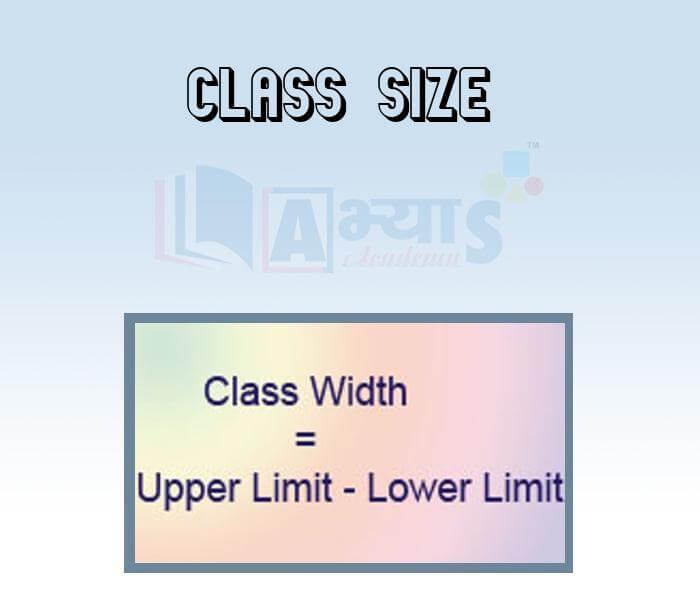Class Size













Class Size
Class Size:Class size is the average number of students per class, calculated by dividing the number of students enrolled by the number of classes. In order to ensure comparability between countries, special needs programmes have been excluded. Data include only regular programmes at these two levels of education and also exclude teaching in sub-groups outside the regular classroom setting. The class size of an overlapping or non overlapping class interval = Actual upper limit – Actual lower limit = Difference of class boundaries.
Illustration: The class size of the overlapping interval 10 - 20 = Actual upper limit – Actual lower limit = 20 – 10 = 10. The class size of the non overlapping class interval 1 – 10 (when the intervals are 1 – 10, 11 – 20, 21 – 30, etc.) = Actual upper limit – Actual lower limit = 10.5 – 0.5 = 10. |
The number of times a particular item occurs in a class interval is called its ________________ | |||
| Right Option : C | |||
| View Explanation | |||
A random survey of numbers of children of various age group playing in a park was found as follows. What is the maximum class size?
| |||||||||||||||||||
| Right Option : D | |||||||||||||||||||
| View Explanation | |||||||||||||||||||
A random survey of numbers of children of various age group playing in a park was found as follows. What is the minimum class size?
| |||||||||||||||||||
| Right Option : A | |||||||||||||||||||
| View Explanation | |||||||||||||||||||
Students / Parents Reviews [10]
It has a great methodology. Students here can get analysis to their test quickly.We can learn easily through PPTs and the testing methods are good. We know that where we have to practice

Barkha Arora
10thAbhyas Methodology is very good. It is based on according to student and each child manages accordingly to its properly. Methodology has improved the abilities of students to shine them in future.

Manish Kumar
10thAbout Abhyas metholodology the teachers are very nice and hardworking toward students.The Centre Head Mrs Anu Sethi is also a brilliant teacher.Abhyas has taught me how to overcome problems and has always taken my doubts and suppoeted me.

Shreya Shrivastava
8thMy experience with Abhyas academy is very good. I did not think that my every subject coming here will be so strong. The main thing is that the online tests had made me learn here more things.

Hiya Gupta
8thBeing a parent, I saw my daughter improvement in her studies by seeing a good result in all day to day compititive exam TMO, NSO, IEO etc and as well as studies. I have got a fruitful result from my daughter.

Prisha Gupta
8thI have spent a wonderful time in Abhyas academy. It has made my reasoning more apt, English more stronger and Maths an interesting subject for me. It has given me a habbit of self studying

Yatharthi Sharma
10thMy experience was very good with Abhyas academy. I am studying here from 6th class and I am satisfied by its results in my life. I improved a lot here ahead of school syllabus.

Ayan Ghosh
8thA marvelous experience with Abhyas. I am glad to share that my ward has achieved more than enough at the Ambala ABHYAS centre. Years have passed on and more and more he has gained. May the centre flourish and develop day by day by the grace of God.

Archit Segal
7thAbhyas is a complete education Institute. Here extreme care is taken by teacher with the help of regular exam. Extra classes also conducted by the institute, if the student is weak.

Om Umang
10thIt was good as the experience because as we had come here we had been improved in a such envirnment created here.Extra is taught which is beneficial for future.
